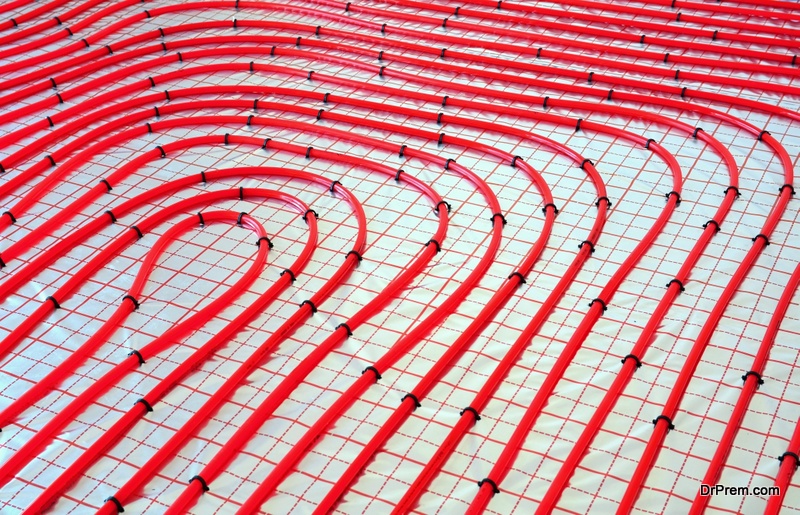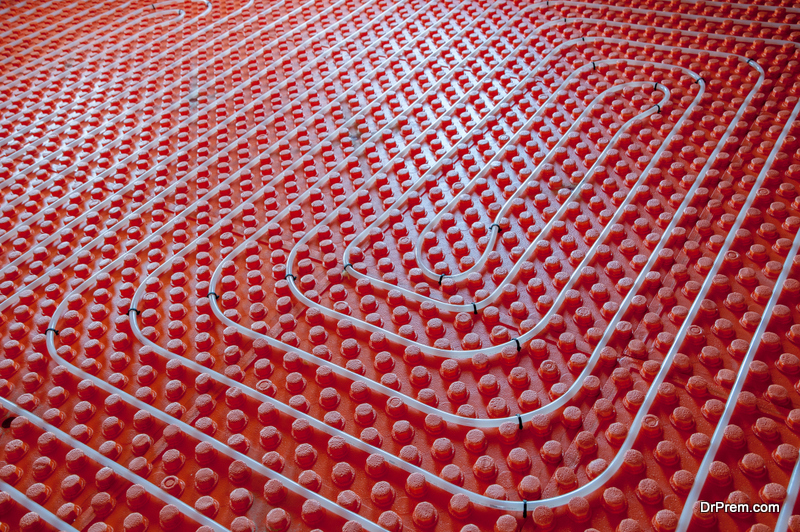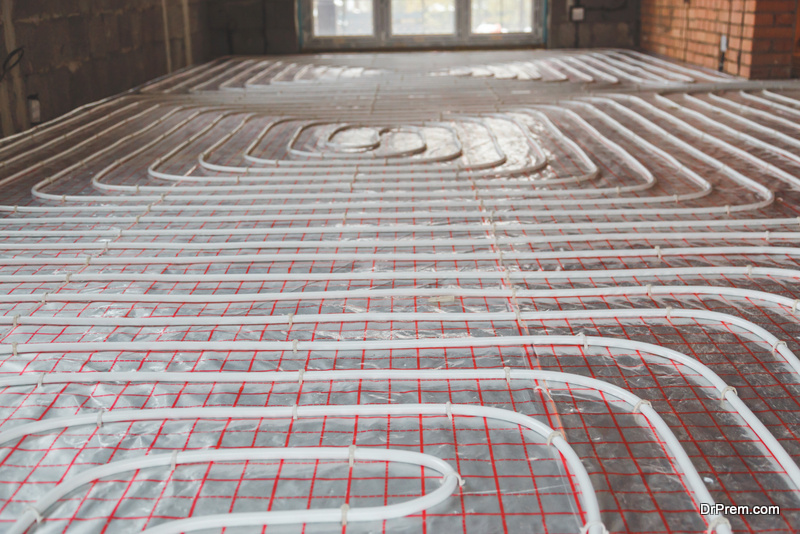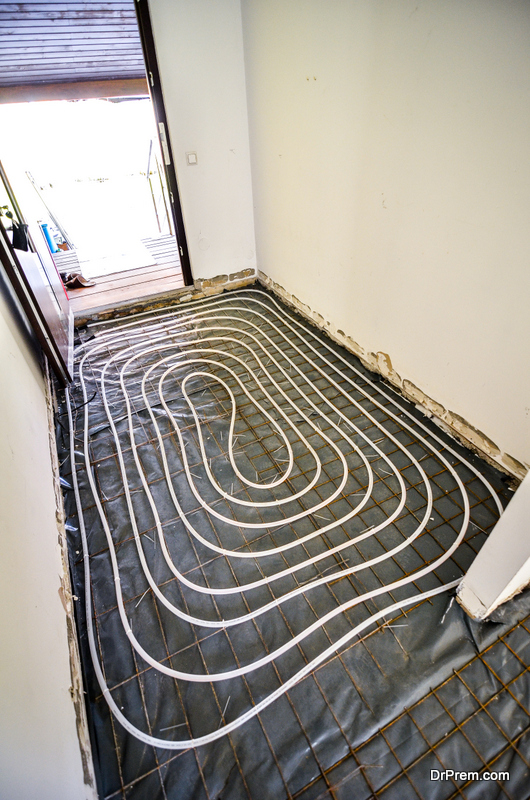Radiant heating can be best explained by the heat that you experience in your kitchen when you cook all day. Radiant heating has to be installed underneath the floor of your home. It is not a common methods of heating homes, but it is certainly very effective. We are used to heating systems which are convective, i.e. the circulated heated air through some space and warm your home. Radiant heating delivers heat through the building’s walls and floors. Let’s see the types of radiant floor heating and its advantages.
9 – Benefits of radiant floor heating
Before learning the benefits of radiant heating, let’s read about the types available.
Electric Radiant Heating
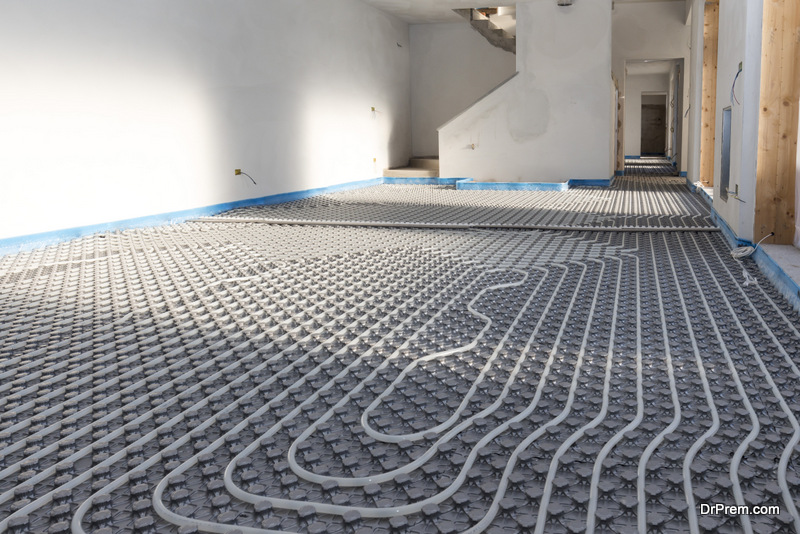 In this system, there are loops of resistance wire which are used to generate heat either in the evening/night or continuously. In some electrical radiant floor heating systems, the cables are run directly inside the material, such as gypsum and concrete, between the floor’s surface and the sub-floor. Other systems fix the cables to conductive panels which amplify the heat.
In this system, there are loops of resistance wire which are used to generate heat either in the evening/night or continuously. In some electrical radiant floor heating systems, the cables are run directly inside the material, such as gypsum and concrete, between the floor’s surface and the sub-floor. Other systems fix the cables to conductive panels which amplify the heat.
Electric radiant heating is usually used for hard floors such as concrete and tile, and is unsuitable for carpeted rooms.
Hydronic or Water Radiant Heating System
Hydronic heat is more popular. These systems have corrosion resistant tubes which circulate hot water throughout the house, via the boiler. The boiler is controlled with the thermostat. New systems have valves which can control the amount of hot water being delivered to each room, and thus allows heat to be shut off or reduced, without reducing heat to remaining part of the home.
With radiant floor heating, you can enjoy advantages such as:
1. Fewer allergies but more heat
There is almost no heat loss in radiant heating, which makes it cost effective too. All the heat generated by the system will warm up your home, unlike convective heating systems. Also, as the heat does not move via the ductwork, so radiant floor heating does not let allergens into your home, thus improving your home’s air quality. So the overall health in your home has the potential to improve.
2. It’s energy efficient
One of the benefits of the radiant heating systems is that they are much more energy efficient than the forced air systems. Radiant floor heating is almost 30% more efficient than forced-air systems, especially those which use water as the medium. These systems need less energy to run which means you get lower electricity bills and thus save money as well. So, radiant systems are cost effective as well.
3. Heat is evenly distributed
You must have felt the icy cold of the floors even though you have the heater on the whole day. This is because heat rises and the heat produced by the heater are constantly dissipated. This, however, will not happen with radiant floor heating systems, as these systems provide a very even distribution of heat throughout the home, and your floors too are nice and warm.
The systems are located underneath the floor, so the heat flows through the floor and there is no chance of icy floors anymore. This is another reason for using less electricity, as there is loss of heat and thus less electricity is required to heat.
4. Less equipment is required
The conventional forced air systems require a lot of components, such as duct work in every room. This has to be maintained in order to work in the optimum manner. Ductwork is difficult to repair and repair is costly too.
But radiant floor heating systems do not need any ductwork. It means they don’t need any registers, radiators, vents or other components which are associated with conventional heating systems. No furnace system is required too. The fewer amounts of components mean that there is much less maintenance cost.
5. Cozy and silent
The radiant heating systems are great for people who love peace and quiet. You won’t hear air blowing throughout the home, as they operate silently. You will realize the sound of the conventional heating systems only when you experience the silence of radiant floor heating.
6. Easy to run
Once a radiant system is installed, it hardly needs any maintenance. Some companies offer long guarantees, as long as 30 years. You can run the system easily with programmable thermostat or Smart thermostats, so you can control it just like any other heating system.
7. You get more options for design
As the whole system is out of sight, you don’t have to deal with unsightly radiators. The most modern of radiators take up space on the walls too, leaving you with less design options. The walls can be decorated unhindered. You have the choice to go for walls chock full of paintings or make a design statement with the minimalist style.
8. It is a safer method of heating
The underfloor system is not exposed so you don’t have to fear about young children being hurt by the hot surfaces or sharp edges of radiators.
9. Easy to install
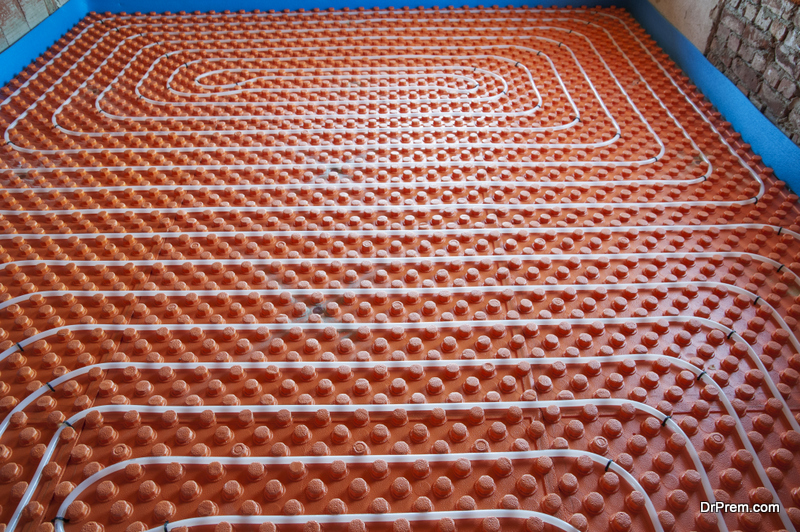 Radiant heating can be installed easily especially if you install when your home is being built or when it is being renovated. It can be rolled out on the floor as the systems are already connected to the wires. Otherwise also, looking at all the advantages, ripping out the floor may be worth it.
Radiant heating can be installed easily especially if you install when your home is being built or when it is being renovated. It can be rolled out on the floor as the systems are already connected to the wires. Otherwise also, looking at all the advantages, ripping out the floor may be worth it.
Drawbacks of radiant heating
1. Installation cost
The cost is usually between dollars 10-20 per sq ft, but it also depends on the system you want to install. You have to add the cost of the electrician too. Water based systems are best installed during the construction of the house.
2. Time of installation
Underneath the electric floor heating system, a self-leveling compound has to be applied. This has to dry completely before floor covering is placed. The water radiant system takes more time to install, but as it is usually completed during a renovation or building project, the time does not matter much. Installation takes about a week to be completed.
3. Floor height
The height of the floors is increased by the less than ½ inch, so you have to consider that. Also, insulation boards have to be placed underneath the heating system, so that will increase the height too. The total height of the floor may be raised by an inch at the end.
Radiant heating is a great way to warm your house efficiently and keep your feet cozy. There are many budget friendly options available so you can check them out and keep your energy costs down in the long run.


